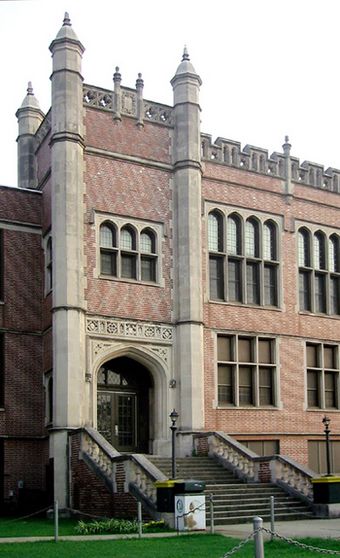Woodlawn, Alabama facts for kids
Woodlawn, Alabama is a community in Jefferson County, Alabama. It's now a neighborhood within the big city of Birmingham, Alabama. Woodlawn started as its own independent community. It even became a city and built a large City Hall building in 1908! But in 1910, Birmingham decided to make Woodlawn part of its city. After joining Birmingham, the Woodlawn area grew a lot.
Contents
Woodlawn Historic District: A Look Back in Time
Quick facts for kids |
|
|
Woodlawn Historic District
|
|

Woodlawn High School (1922)
|
|
| Location | Roughly bounded by 1st Ave. N, 47th St. N, 61st St.N, and I-20/59, Birmingham, Alabama |
|---|---|
| Area | 241 acres (0.98 km2) |
| Architectural style | Queen Anne, Late 19th and 20th Century Revivals |
| NRHP reference No. | 03001129 |
| Added to NRHP | November 17, 2003 |
The Woodlawn Historic District in Birmingham, Alabama is a special area. It's like a time capsule! This district was added to the National Register of Historic Places in 2003. It covers about 241 acres (almost 1 square kilometer).
This historic district includes many old buildings that tell Woodlawn's story. It has 608 buildings that are important to history. It also has one historic site. The district covers much of the original city of Woodlawn. It even includes the old City Hall. The area continued to grow a lot after Woodlawn joined Birmingham.
Important Buildings in the District
The Woodlawn Historic District has many cool old buildings. Some of these buildings are already famous on their own! They show different styles of architecture from the late 1800s and early 1900s. Here are some of the most well-known:
- Woodlawn City Hall (built in 1908): This building has a grand style called Beaux Arts.
- Woodlawn Fire Station (around 1930): Built in a romantic French revival style.
- Woodlawn Masonic Building (1915): A historic meeting place.
- Woodlawn High School (1922): Designed in the Tudor Revival style. It also has a gym and a stadium.
- Grace Episcopal Church (around 1910): An old church building.
- Woodlawn Public Library (1950): Built in a more modern style.
- Wood Family Cemetery (1824): This is the oldest known site in the district.
The district is generally found between 1st Avenue North, 47th Street North, 61st Street North, and Interstate 20/59.
Woodlawn's Past: A Brief History
Woodlawn has a long and interesting history. The first European-descended families arrived in the area around 1815-1816. These included the Hawkins, Riley, Eubank, and John Smith families.
Early Settlers and Community Growth
One important early settler was Obadiah Washington Wood Sr. He had a home called "Woodlawn" on the old Georgia Road. His relative, Edmund Wood, lived at "Willow Wood." This was where Willow Wood Park is today.
Obadiah W. Wood Sr. helped the community grow a lot. He opened the first general store. He also started the first post office in 1832. At that time, the community was known as Rockville. He also built the first saw mill in the area. Mr. Wood was very generous. He gave land for railroads and streetcars. He also donated land for four churches and a school. He even gave land for former slaves to settle at nearby Zion City.
A church was built on land donated by Obadiah W. Wood Sr. It was used by all different church groups for "Union services." This was at what is now 56th Street and Second Avenue. The Woodlawn Elementary School was later built there.
The Wood Family Cemetery
The Wood Family Cemetery is a very old place. It has about 150 graves. The first burials happened around 1824. Seven generations of the Wood family are buried there. This includes Obadiah and Edmund Wood. The cemetery is about 2 acres (0.8 hectares) large. It's located on 57th Street North at First Avenue.
From Farmland to City
For a long time, Woodlawn was mostly farmland. It was a good place for settlers because it was on the Georgia Road. It also had fertile land and plenty of water.
The population of Woodlawn was small at first. In 1880, only 89 people lived there. But by 1890, the population had jumped to 1,506!
New churches were built in the late 1880s. Railroads also came to the area. The Georgia Pacific Railroad (later Alabama Great Southern) was finished by 1883. Other lines like the Central of Georgia and Birmingham Mineral came by 1888.
The community changed its name to Woodlawn in 1886. On January 26, 1891, Woodlawn officially became its own city! The new city's borders were generally from 47th Street to 65th Street. They ran between 12th Avenue North and 7th Avenue South. Streetcar services helped the city grow even more.
Joining Birmingham
Woodlawn became part of Birmingham on January 1, 1910. This was a big change! It meant Woodlawn got better city services. This led to even more building and growth in the area.
Images for kids



